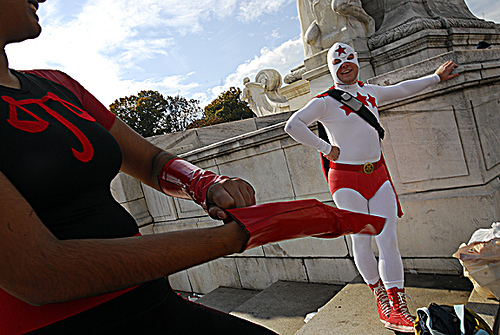PHOENIX JONES; REX VELVET & THE REAL LIFE SUPERHERO DEBATE.
Seattle is home to Earth’s best known RLSH, Phoenix Jones, recently unmasked as mixed martial artist Benjamin Fedor. It also has a rising star ” real life supervillain ( RLSV ) “/satirist called Rex Velvet, whose wit and production skills are impressive.
At issue is the debate about whether ” real life superheroes ” , especially those actively performing citizens arrests, should even exist? Jones and Velvet represent the poles between which this debate swings.
For boring activists like me it’s quite a show.
Rex Velvet and other RLSVs aren’t actual criminals who’ve gone comic book on society. They seem to be social critics concerned with RLSH potential to advocate vigilantism and undermine the police. These are legitimate concerns to be sure and these creative commentators have made such critiques a brand.
Sympathetic ” Real life supervillains ” advise RLSH not to carry deadly weapons; doff costumes and stay within the letter of the law. Unsympathetic ones demand the abolition of ” real life superheroes ” in the name of supporting the police. If anything RLSVs resemble outraged civic leagues more than a legion of doom.
Phoenix Jones represents the full contact wing of the ” real life superhero ” movement. Media coverage and Jones’ own chest camera capture he and his Rain City Superhero Movement team breaking up fights and restraining suspects.
Some RLSH don’t actually attempt to fight crime. Others do and include charitable outreach while making their rounds. My opinion on the debate is challenging convention gets more people involved to helping society.
My only caveat is making sure stretching reality doesn’t extend into delusion or worse. In that regard ” real life supervillains ” and I agree. People who really think they’re really ” superheroes ” or ” supervillains ” could be a problem.
I hope the middle ground between Rex Velvet and Phoenix Jones, people inventively assisting and commenting on today’s problems, would get as much air time.
The ” real life superhero ” debate is really a much needed new wrinkle the age old one about the limits of civic responsibility- especially during trying times when terrorism and a global recession beat down folks spirits.
If people want to call themselves superheroes or supervillains and aren’t hurting anyone I say more power to them.
Those causing harm however aren’t doing this debate nor themselves any good.
NADRA ENZI AKA CAPT BLACK promotes creative crime prevention. The following links outline what I do:
http://archives.reallifesuperheroes.org/wiki/captain-black/ Wiki entry on my Capt Black activities.
http://www.youtube.com/watch?v=kpmgtpc4ulg&feature=youtu.be Canal St. Superhero documentary about me done by Dr. Jonathan Gayles from Georgia State University.
http://bit.ly/KKcAv6 Interview with myself and Tim Washington of Brothers Against Crime with New Orleans FOX 8 News about our anti-crime efforts.
CAPT BLACK: (504) 214-3082






